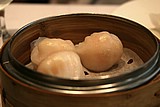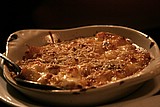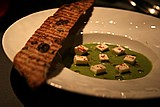Home |
Restaurants by City
|
Food Photography |
Archive | Philosophy |
![]()
Right now we are eating in Seattle, Washington.
|
Wednesday
2006
Permalink
|
A Week at the Culinary Institute of America (continued) - The Facilities, Hyde Park, NY, tasted on December 19-22, 2005 I'm going to attempt to give you a sense of our week at the C.I.A. Rather than describe things in strict chronological order I'm going to focus on a few themes from the experience. There's a lot to cover so hang on. The first thing that has to be called out is the first impression that the school makes on you. Let's acknowledge that if you're reading this blog (and certainly if you're writing it, which I am) you (and I) have spent time romanticizing particular food experiences as well as the process that results in the creation of the chefs that cook the food you love. I'll apologize in advance for anyone for whom this analogy doesn't work, but the C.I.A. is essentially Hogwarts for food. It's just like a regular school except everything is focused on food. It's enough to make an adult giggle. I'm not even sure why. I guess if you're into food, going to a school where they take it so seriously is kind of neat (and a little surreal). Let's be specific. Walking down the halls and seeing classes like Confectionary Art & Special Occasion Cakes and Individual and Production Pastries, Contemporary Cakes & Desserts Basic & Classical Cakes, and Chocolates & Confections, Cookies, Tarts, & Mignardises. That's right, mignardises! Don't even get me started on "Confectionary Art". I'm sorry to gush so much, but it's really the only way to convey the excitement of the moment. And believe me, it took a lot to be excited given that we arrived on our first day early in the morning searching for our classroom. Hyde Park, NY in late December is a pretty cold place. At 6 am it just sucks. But this was part of the fun. If you're going to go to baseball fantasy camp, you expect that there's going to be all the "texture" of the experience including a spit bucket filled with used chaw. We were lucky not to have any spit buckets (except in wine tasting class) but getting up at 5am to get to school by 6am in the freezing cold and dark was part of the charm. Back on the Hogwarts theme, at the center of the campus is an almost castle-like former Jesuit Seminary that the school bought in the 70's and converted into the school. The main hall is even reminiscent of the Hogwarts great hall having been converted from the seminary's grand chapel into what else? the main dining hall of the school. If you're going to worship at the C.I.A. it should be food on the receiving end of your adulation. And this is where quite a bit of that prayer and communion happens. There was just a charm to the whole place. Part of our week included a tour of the campus. Ever been to a university bookstore? This one is indistinguishable from some of the best cookbook stores you've ever shopped at. Multiple restaurants and cafes dot the campus where students do rotations not just in the kitchens and bakeries but as waiters as well learning what working in the front of the house entails. The kitchens are numerous. I lost count, but I think our kitchen was #17. And while it was one of the biggest, enough to accommodate probably 25-30 people cooking simultaneously, many of the others were pretty large as well. Some were mostly classrooms, but many were dedicated to feeding the student body. Everything in this place revolves around the creation of and consumption of food. It's cool. The heart of the entire operation is the store room. They order, store, and distribute ingredients for the numerous kitchens across campus. Making friends with the staff there seems essential to anyone's survival. That said, even for people with the best connections, paperwork is the red blood cell of this arterial system. No food leaves the store rooms without the right paperwork so the accounting can be done of what money got spent to make what food in what classroom to feed which students. Got that? They do. Our tour of the store room seemed to go on forever as we passed the basic ingredients as well as the expensive ones. Pink peppercorns, hot sauce, saffron, bulghur, Israeli couscous, Szechuan peppercorns, Persian limes, galangal, as well as racks and racks of all manner of cheeses. We couldn't help but ask where all the high end ingredients were, not that they're required to make a great dish, but we were curious if they stocked them. Sure enough we came upon the quail eggs and caviar in short order. The store room (which was really many many rooms as well as bunches of walk-in refrigerators) went on and on and on. Walking around the main building, just about every kitchen is visible through glass windows that line the walls of hallways. Often the food being prepared by the students is placed just in front of those windows for all to see. Needless to say, walking by beautifully made chocolates and candy orange slices just added to the magic of the place.
As if to make sure the experience was brought home for us, our duffel bags not only had chef's whites for us to wear, but also included text books and our own set of kitchen knives and tools. Hopefully we'd be able to put it all to good use. Next post we touch a little bit on the life of students at the C.I.A.
|
|||
Our Sponsors
Free Car Listings Hot Tubs Stools Saunas Bar Stools - Calendar and Event Schedules - Food Events and Calendars - Wine Events and Calendars - Digital Photography Resources - Software for Advertisers - Jewish Gifts and Judaica - Howard Stern Podcast - ponytailed blogger Jonathan Schwartz

Browse tastingmenu
Home |
Restaurants by City X |
Food Photography |
Archive | Philosophy |
![]()
Free eBooks: All About Apples
| Autumn Omakase
More:
Discussion |
Cool Food T-Shirts |
Ingredients
| Markets |
Recipes
Search |
Blog FAQ |
Other
Blogs
Best of tastingmenu
|
City View
Entry: July 6, 2006 |
Blue Plate
Entry: June 19, 2006 |
L'Atelier de Joël Robuchon
Entry: July 18, 2006 |
Browse by City
Boston | Chicago | Houston | Las Vegas | Los Angeles | Maui | New York | Philadelphia | Portland | San Francisco | Seattle | Toronto | Utah | Vancouver | Washington D.C.
Bangkok | Beijing | Hong Kong | Seoul | Tokyo
Amsterdam | Berlin | Italy | London | Madrid | Paris | Vienna
Browse by Month
2006
2005
2004
2003
2002
2001
Comments, questions, or feedback:
info / at / tastingmenu / dot / com
All pages Copyright (c) 2001-2006 tastingmenu.com
Last modified 01/30/07.





